
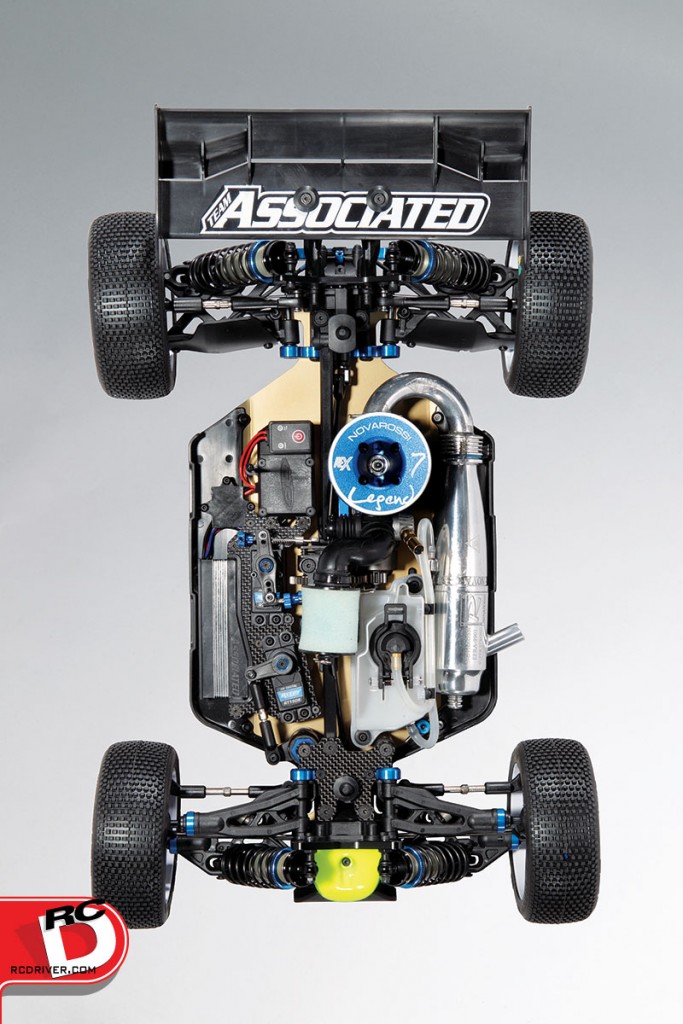
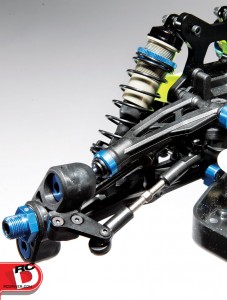
CHASSIS- In past reviews of the RC8 platform offerings we told you what varied from vehicle to vehicle, but here we have to start from scratch because the RC8B3 shares just about nothing with its predecessors. The 3mm thick, hard anodized aluminum chassis features a narrow cut under the transmission with large wings coming out for the droop screws to hit. The center section is a nearly rectangular shape with angled edges to increase strength. Just two cut-outs allow flywheel and spur gear clearance while the engine mounting screw locations are slotted and recessed to allow mesh adjustments. On the top side, composite braces steady up the front and rear of the vehicle and low profile mud-guards bolt to both sides to keep debris off of components. Since it’s a race machine, it needs carbon fiber and AE did not disappoint, the radio plate and front upper plate are beautifully machined from the sturdy material.
SUSPENSION- Team Associated went in a whole new direction with the suspension in comparison to its predecessor, the RC8B3 features a pivot ball with uprights set-up on the front end. Pivot ball suspension isn’t new to the RC industry and has been used on more vehicles than I who have been in the RC hobby for over thirty years can think of so enough with the copycat comments, web warriors. The pivotball front end proved to be the most nimble for a wide range of drivers according to AE’s testing and they utilized its design so more drivers can enjoy success behind the wheel. The arms seem tough, so tough I had to use a power drill with hex bit to screw the pivot balls into the arms. Aluminum caps slip over the arms to prevent the pillow balls from splitting the arm in a crash. The pillow balls are steel and the uprights are a hefty composite with steering arms that bolt 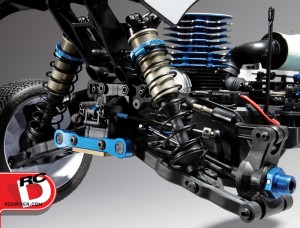 on with optional arms soon to come. The rear arms, like the front, are hefty and feature plenty of bracing. There are two shock mounting locations on the arms for ease of tuning and dirt shields for the rear arms are included to deflect debris. Aluminum pivot blocks are supplied for all five block locations and several parts trees loaded with various inserts let you tune your RC8B3 to track conditions. There are plenty of roll adjustment options and the thick rear turnbuckles allow easy, precise, camber tuning. Now we can move on to the shocks, these massive 16mm bore oil-filled, coil-over aluminum shocks feel oh-so-smooth and AE stuffed 3.5mm shafts in the dampers for maximum durability without the thickness of the shaft effecting the displacement in the shock when it cycles. The shocks bolt to thick, machined aluminum towers.
on with optional arms soon to come. The rear arms, like the front, are hefty and feature plenty of bracing. There are two shock mounting locations on the arms for ease of tuning and dirt shields for the rear arms are included to deflect debris. Aluminum pivot blocks are supplied for all five block locations and several parts trees loaded with various inserts let you tune your RC8B3 to track conditions. There are plenty of roll adjustment options and the thick rear turnbuckles allow easy, precise, camber tuning. Now we can move on to the shocks, these massive 16mm bore oil-filled, coil-over aluminum shocks feel oh-so-smooth and AE stuffed 3.5mm shafts in the dampers for maximum durability without the thickness of the shaft effecting the displacement in the shock when it cycles. The shocks bolt to thick, machined aluminum towers.
DRIVETRAIN- The driveline is where you can find some pretty neat features, starting with the lightweight diffs and outdrives to keep rotating weight down. The diffs are sealed and oil-filled with Lucas Oil provided from the factory to fill all three. The universals are a thin driveshaft to again reduce weight on the front, center and rear. What is interesting in the driveline is that AE chose a dual shield bearing, rubber for the dirt side and metal for the inner sides so the bearings have less drag. The bearings also have a smaller diameter than what we’re used to seeing but they are a flanged type bearing for better strength in most locations. To slow the buggy, machined steel discs are clamped by bonded pads with springs to help separate the brakes when you roll off the binders. Getting power from the engine to the flywheel is an aluminum three-shoe clutch with three aluminum shoes that spin the included steel clutchbell. I like AE’s easy-to-install clutch spring design.
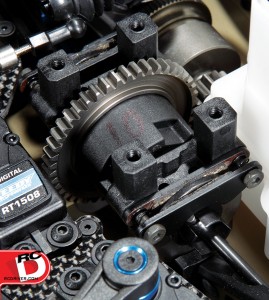
STEERING- For steering, I’ve seen Team Associated try a number of revisions of steering types over the years, but here they’ve gone with the tried and true bell crank setup with servo saver on the main crank and an aluminum drag link bar with adjustable Ackermann positions connecting the two. The steering is loaded with bearings for smooth operation and the servo saver spring collar is a clamping type collar so it won’t back off while you’re racing hard. AE includes servo horns with metal inserts, which are less likely to strip in a crash, to mate up with your specific servo.
NOTEWORTHY- Let’s talk additional neat features like the smaller differentials with easy access gear cases that allow easier, quick diff pulls for maintenance or tuning. The swaybars are another neat feature in that they are held in place by a swing-away plate and centered with a single collar located on the center of the bar. Then there’s the lower shock mount pin rather than a screw that could possibly back out. The throttle linkage features steel bushings so the arms move freely and the linkages are easy to adjust with thumb nuts. Over on the tank, the clunk style tank has walls to catch spilt fuel and guide it down a spill hole the empties out of the bottom of the chassis. Next to the tank you’ll see the inline barrel filter that makes finding foam filter elements so much easier at your local shop.
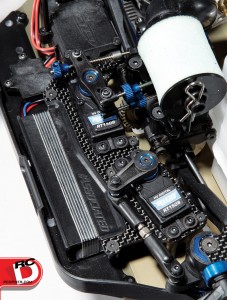
SPECS & TUNING OPTIONS
Dimensions
Length: 19.2 in. (488mm)
Width:
Wheelbase: 12.8 – 13 in. (325 – 330mm)
Weight:
Body, Wheels and Tires
Body: Pro-Line cab-forward clear body
Wheels: NA
Wheel adapter type: 17mm
Tires: NA
Suspension
Type: Pillowball front, H-arm with upper link rear
Shock positions: 5 tower/ 2 arm
Camber: Adjustable turnbuckle
Roll: Adjustable front and rear
Wheelbase: Adjustable at rear hub and arm
Ride height: Shock Pre-load collars
Misc: Droop, optional swaybars and springs
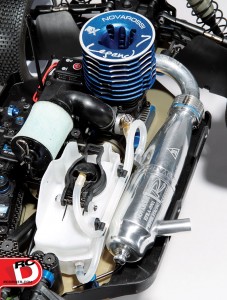
Steering
Type: Bellcrank
Toe: Adjustable turnbuckle
Chassis
Type: Machined plate
Material: 7075 T-6 Aluminum
Thickness: 3mm
Drivetrain
Type: AWD
Transmission: Shaft
Differential: Oil filled gear differential
Clutch Type: 3-shoe
Gear ratio: 3.38:1
Bearings: Half metal/ half rubber shield
 RC Driver The Best In RC Car & Truck News, Reviews & Video
RC Driver The Best In RC Car & Truck News, Reviews & Video 








